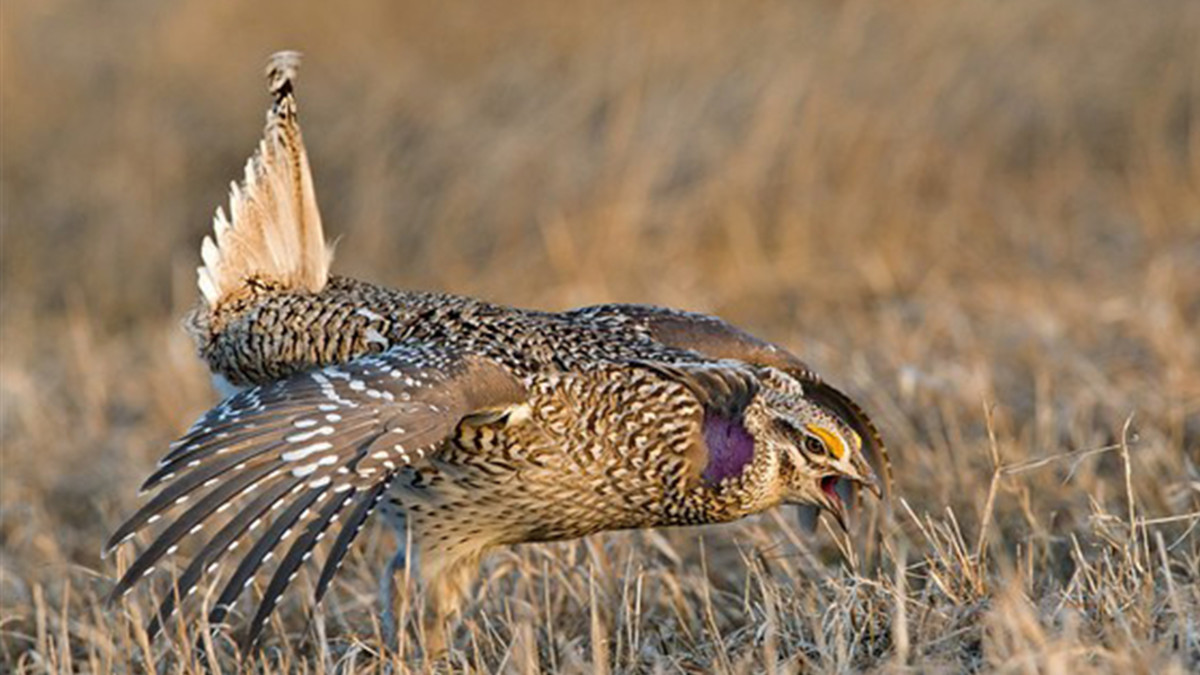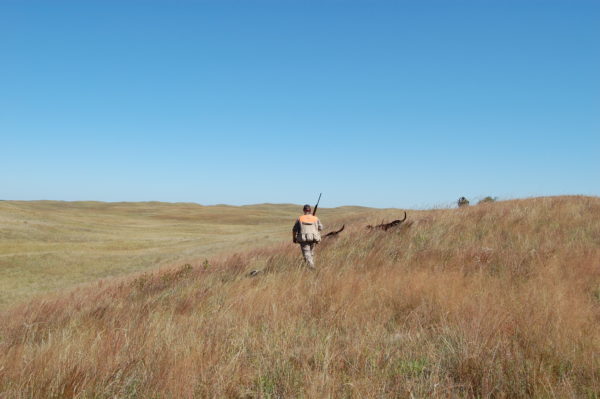
Sharp-tailed grouse are best known for their “leks,” or traditional breeding sites, whereas many 15 males will congregate on the wide open prairie to compete for female attention by strutting, cackling, and stomping their feet in a strangely synchronized dance.
The spring breeding season isn’t the only time when sharp-tailed grouse will gather into large flocks. During the late fall and early winter, it’s not uncommon for hunters to flush flocks of over one hundred sharp-tailed grouse or to see that many birds feeding on buds while perched 20 feet up in a tree. In this way, sharp-tailed grouse are much different than their solitary ruffed grouse cousins who occupy forested terrain.
The gregariousness of the sharp-tailed grouse should put hunting them on the to-do list of any easterner who’s spent his or her life chasing ruffed grouse, as it’s possible that you could flush more sharp-tailed grouse in a single outing than all the ruffed grouse that you’ll flush in a decade of stomping brush at home.
Do not make the mistake of thinking that sharp-tailed grouse are easy. You might get lucky enough to flush a flock of one hundred, but you’ll still only get off one or two shots before they’re long gone. Bagging a limit of these extremely wary birds is a feat to be proud of.
Scientific Name
Tympanuchus phasianellus
A.K.A.
Prairie grouse, sharptail, sharpy.
Barroom Banter
Sharp-tailed grouse were once common in the Great Lakes states of Michigan, Illinois, Wisconsin, and Minnesota, though their numbers and distribution have fallen greatly due to habitat loss. The birds will not typically tolerate an area where more than 50% of the landscape is forested. Prior to European settlement, wildfires helped create suitable mosaics of open habitat where the birds were able to thrive.
Wetland edges also provided superb habitat. In the centuries since European contact, a combination of factors including fire suppression, development, high-intensity agriculture, and wetlands destruction have resulted in the disappearance of the birds across much of their historic range.
Physical Description
Sharp-tailed grouse are mottled brown, beige, and white, and appear to be spotted. Undersides are lighter than upper portions, with small, dark V-shaped patterns. The tail is short, much shorter than that of a hen pheasant and on a flying bird it appears to be sharply pointed. The head is slightly crested. Males have an eye comb and reach 2 ½ pounds. Females are slightly smaller.
Habitat
Open grasslands, natural or agricultural, particularly the short-grassed prairie of the central Plains. Habitat must include brushy draws and coulees. The species will not usually tolerate areas where more than 50% of the land is forested.
Diet
Rosehips, buffalo berry, berries, herbaceous plants, agricultural grain crops, catkins and buds from shrubs and trees, and grasshoppers
Breeding and Reproduction
Polygamous. Females nest on the ground and will lay 9 -12 eggs.
Life and Death
Predation on sharp-tailed eggs is very common. Of those birds that hatch, most die within a year. Adults often live to be 3 years old. Avian predators such as hawks are a leading killer of sharp-tailed grouse. Extreme winter weather also kills many.
Telltale Sign
Very little during snow-free conditions besides piles of droppings. In winter, look for tracks.
Edibility
Quite good. The flesh is dark, though it lacks the livery quality of ptarmigan.
Hunting Opportunities
Common throughout Canada, Alaska and some areas in the middle of the United States. As with other grouse, the usual season lasts from September until January, with longer seasons in Alaska. Limits range from three to five and are often counted towards a combined limit total.

Hunting Methods
The best way to locate sharp-tailed grouse is to hunt within a couple of miles of a known lek. It’s also smart to stay in the vicinity of active roosting areas, as sharp-tailed grouse will typically feed within a couple miles of their roost. When hunting mornings and late afternoons, look for the birds around crop fields of grain or alfalfa, or else in the vicinity of preferred natural foods such as berries, rose hips, or seed-bearing wild plants that can be found along brushy fencerows, coulee bottoms, abandoned farmsteads, and stream channels. Between feeding sessions, sharp-tailed grouse will move to loafing areas.
Un-pressured birds will loaf in sparse grasslands, with just enough cover to conceal them from avian predators. In windy conditions, look for the birds to be concentrated on the lee side of hills. Heavily hunted birds, on the other hand, will seek shelter in much denser grass or they’ll hide in areas that might be more readily recognized as pheasant cover. As hunting season progresses and weather conditions deteriorate, sharp-tailed grouse will begin to spend more and more time in the vicinity of sheltering windbreaks such as clusters of brushy trees and stands of conifers.
In deep snow, the birds will roost beneath the snow. During a storm, they might stay under the snow for so long that any trace of their presence on the snow’s surface will be erased. The unsuspecting hunter who flushes one of the snow-roosted birds is likely to get so startled by the explosion of feathers and snow that they’ll miss their chance to take a shot.
Spotting the Wary Birds
Sharp-tailed grouse are exceptionally wary, and the relative openness of their habitat allows them to see and hear you coming from a long way off. You should keep quiet and avoid talking and yelling. An added bonus of keeping quiet is that you might hear the birds, they make a host of sounds while feeding in the morning, including clucks and whines.
The birds might hold well for a pointing dog in the early season, but heavily pressured birds will typically flush before you can catch up with your dog if he works far out. During late season, it’s better to have a close-working dog that hunts within shotgun range.
Sometimes sharp-tailed grouse will become so wary that it’s virtually impossible to approach them within shotgun distance. Under these conditions, try hunting them as early in the morning as possible. For whatever reason, they often hold tighter in the morning. Also consider the possibility of pass-shooting as the birds travel from their roosting areas to feeding areas, or from feeding areas to loafing areas. This can work well, though it takes some scouting effort to identify the exact travel routes used by the birds as they go about their day.
Flushing Sharp-Tailed Grouse
When you do flush a flock of sharp-tailed grouse, watch where they go, especially if the flock breaks up into several smaller flocks. Mark their locations and then try to re-flush them. The birds tend to hold a little tighter the second time around, perhaps because they are tired from flying and are thus more reluctant to get back up again.
Pheasant hunters often miss opportunities on sharp-tailed grouse because they mistakenly think that the birds are hen pheasants and then pass them up. Don’t let this happen to you. A sharp-tailed grouse’s tail is much shorter than a hen pheasants, and it appears to be sharply pointed on a flushing bird. Also, sharp-tailed grouse will often make an urgent sounding kuk-kuk-kuk-kuk call upon flushing. If you hear that, get ready to shoot. As long as it’s open season for sharp-tailed grouse in your hunting area, of course.
During the early season, when the birds are likely to hold tighter, a modified choke with #6 pellets is a wise choice. During the late season, it’s not a bad idea bump up to a full choke and #4 or #5 shot if the birds are flushing way out ahead of you.






Conversation